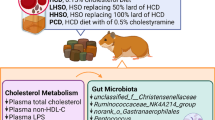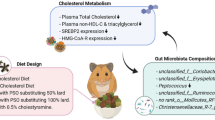Abstract
Hypolipidemic effects of Agastache rugosa essential oil (AREO) were investigated. Gas chromatographymass spectrometry (GC-MS) analysis showed that the major compound in AREO is limonene (47%, w/w). AREO (1 mg/mL) markedly reduced low density lipoprotein (LDL) oxidation (−93%). After 3-week feeding of AREO, plasma cholesterol (−28%) and triglyceride levels (−26%) were significantly decreased in C57BL/6J mice. Mouse hepatic transcriptome profiling with oligonucleotide microarray revealed that AREO altered the expression of 2,524 genes. Notably, significant reductions in sterol regulatory element binding factor (SREBF)-1 and SREBF-2 mRNA levels were detected. Protein expression of HMG-CoA reductase, a major target for SREBP-2, was reduced in HepG2 cells (−36%) and in mouse liver (−35 %). AREO also significantly increased mRNA (+40%) and protein (+83%) expression of the LDL receptor in HepG2 cells and mouse liver, respectively. Our findings suggest that AREO may prevent atherosclerosis via the inhibition of LDL oxidation, down-regulation of SREBF-2 and HMG-CoA reductase expression, and up-regulation of LDL receptor expression.
Similar content being viewed by others
References
Hu FB, Willett WC. Optimal diets for prevention of coronary heart disease. J. Am. Med. Assoc. 288: 2569–2578 (2002)
Ansell BJ, Watson KE, Fogelman AM. An evidence-based assessment of the NCEP Adult Treatment Panel II guidelines. National Cholesterol Education Program. J. Am. Med. Assoc. 282: 2051–2057 (1999)
Steinberg D. Arterial metabolism of lipoproteins in relation to atherogenesis. Ann. NY Acad. Sci. 598: 125–135 (1990)
Silverstein RL. Inflammation, atherosclerosis, and arterial thrombosis: Role of the scavenger receptor CD36. Cleve. Clin. J. Med. 76(Suppl 2): S27–S30 (2009)
Best JD, Jenkins AJ. Novel agents for managing dyslipidaemia. Expert Opin. Inv. Drug 10: 1901–1911 (2001)
Hong JH, Choi JH, Oh SR, Lee HK, Park JH, Lee KY, Kim JJ, Jeong TS, Oh GT. Inhibition of cytokine-induced vascular cell adhesion molecule-1 expression; possible mechanism for antiatherogenic effect of Agastache rugosa. FEBS Lett 495: 142–147 (2001)
Blaszczyk T, Krzyzanowska J, Lamer-Zarawska E. Screening for antimycotic properties of 56 traditional Chinese drugs. Phytother. Res. 14: 210–212 (2000)
Shin S. Essential oil compounds from Agastache rugosa as antifungal agents against Trichophyton species. Arch. Pharm. Res. 27: 295–299 (2004)
Shin S, Kang CA. Antifungal activity of the essential oil of Agastache rugosa Kuntze and its synergism with ketoconazole. Lett. Appl. Microbiol. 36: 111–115 (2003)
Kim HK, Lee HK, Shin CG, Huh H. HIV integrase inhibitory activity of Agastache rugosa. Arch. Pharm. Res. 22: 520–523 (1999)
Min BS, Hattori M, Lee HK, Kim YH. Inhibitory constituents against HIV-1 protease from Agastache rugosa. Arch. Pharm. Res. 22: 75–77 (1999)
Sandoval IV, Carrasco L. Poliovirus infection and expression of the poliovirus protein 2B provoke the disassembly of the Golgi complex, the organelle target for the antipoliovirus drug Ro-090179. J. Virol. 71: 4679–4693 (1997)
Lee C, Kim H, Kho Y. Agastinol and agastenol, novel lignans from Agastache rugosa and their evaluation in an apoptosis inhibition assay. J. Nat. Prod. 65: 414–416 (2002)
Grosskopf I, Baroukh N, Lee SJ, Kamari Y, Harats D, Rubin EM, Pennacchio LA, Cooper AD. Apolipoprotein A-V deficiency results in marked hypertriglyceridemia attributable to decreased lipolysis of triglyceride-rich lipoproteins and removal of their remnants. Arterioscl. Throm. Vas. 25: 2573–2579 (2005)
Lee SJ, Grosskopf I, Choi SY, Cooper AD. Chylomicron remnant uptake in the livers of mice expressing human apolipoproteins E3, E2 (Arg158—>Cys), and E3-Leiden. J. Lipid Res. 45: 2199–2210 (2004)
Chung MJ, Kang AY, Park SO, Park KW, Jun HJ, Lee SJ. The effect of essential oils of dietary wormwood (Artemisia princeps), with and without added vitamin E, on oxidative stress and some genes involved in cholesterol metabolism. Food Chem. Toxicol. 45: 1400–1409 (2007)
Schuh J, Novogrodsky A, Haschemeyer RH. Inhibition of lymphocyte mitogenesis by autoxidized low-density lipoprotein. Biochem. Bioph. Res. Co. 84: 763–768 (1978)
Lee SJ, Moye LA, Campos H, Williams GH, Sacks FM. Hypertriglyceridemia but not diabetes status is associated with VLDL containing apolipoprotein CIII in patients with coronary heart disease. Atherosclerosis 167: 293–302 (2003)
Bradford MM. A rapid and sensitive method for the quantitation of microgram quantities of protein utilizing the principle of protein-dye binding. Anal. Biochem. 72: 248–254 (1976)
Ritchie ME, Silver J, Oshlack A, Holmes M, Diyagama D, Holloway A, Smyth GK. A comparison of background correction methods for two-color microarrays. Bioinformatics 23: 2700–2707 (2007)
Yang YH, Dudoit S, Luu P, Lin DM, Peng V, Ngai J, Speed TP. Normalization for cDNA microarray data: A robust composite method addressing single and multiple slide systematic variation. Nucleic Acids Res. 30: e15 (2002)
Bolstad BM, Irizarry RA, Astrand M, Speed TP. A comparison of normalization methods for high density oligonucleotide array data based on variance and bias. Bioinformatics 19: 185–193 (2003)
Tusher VG, Tibshirani R, Chu G. Significance analysis of microarrays applied to the ionizing radiation response. P. Natl. Acad. Sci. USA 98: 5116–5121 (2001)
Djordjevic D, Cercaci L, Alamed J, McClements DJ, Decker EA. Chemical and physical stability of protein and gum arabic-stabilized oil-in-water emulsions containing limonene. J. Food Sci. 73: C167–C172 (2008)
Karlberg AT, Magnusson K, Nilsson U. Influence of an anti-oxidant on the formation of allergenic compounds during auto-oxidation of d-limonene. Ann. Occup. Hyg. 38: 199–207 (1994)
Endemann G, Stanton LW, Madden KS, Bryant CM, White RT, Protter AA. CD36 is a receptor for oxidized low density lipoprotein. J. Biol. Chem. 268: 11811–11816 (1993)
Shashkin P, Dragulev B, Ley K. Macrophage differentiation to foam cells. Curr. Pharm. Design 11: 3061–3072 (2005)
Daniels TF, Killinger KM, Michal JJ, Wright RW Jr, Jiang Z. Lipoproteins, cholesterol homeostasis, and cardiac health. Int. J. Biol. Sci. 5: 474–488 (2009)
Brown MS, Goldstein JL. A proteolytic pathway that controls the cholesterol content of membranes, cells, and blood. P. Natl. Acad. Sci. USA 96: 11041–11048 (1999)
Ferdowsian HR, Barnard ND. Effects of plant-based diets on plasma lipids. Am. J. Cardiol. 104: 947–956 (2009)
Author information
Authors and Affiliations
Corresponding author
Rights and permissions
About this article
Cite this article
Jun, HJ., Chung, M.J., Dawson, K. et al. Nutrigenomic analysis of hypolipidemic effects of Agastache rugosa essential oils in HepG2 cells and C57BL/6 mice. Food Sci Biotechnol 19, 219–227 (2010). https://doi.org/10.1007/s10068-010-0030-1
Received:
Revised:
Accepted:
Published:
Issue Date:
DOI: https://doi.org/10.1007/s10068-010-0030-1




